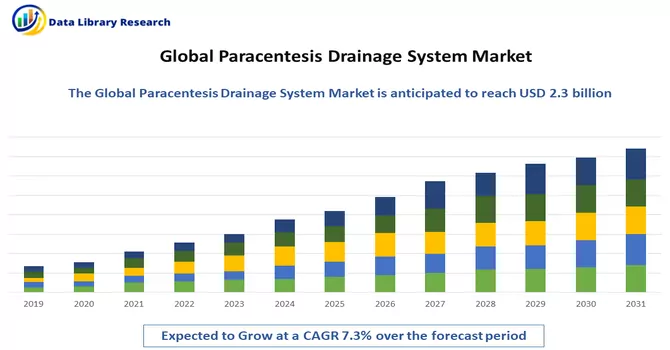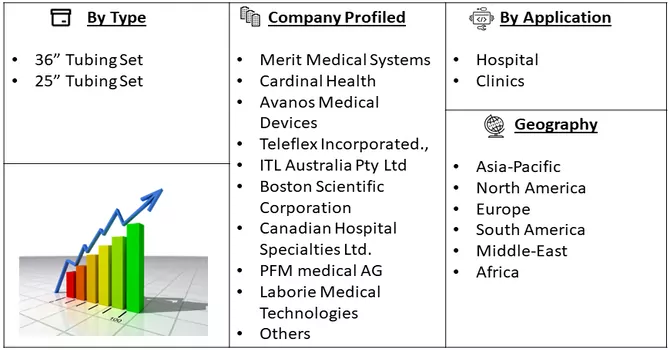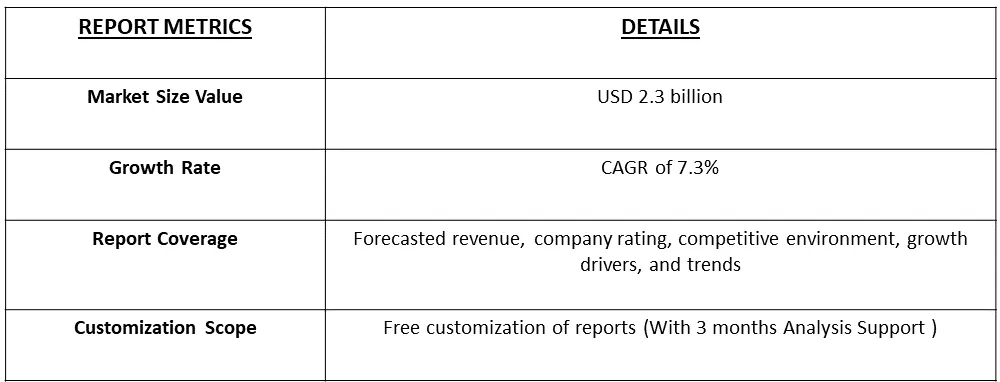The paracentesis drainage systems market size is anticipated to surpass USD 2.3 billion in the year 2023, growing at a CAGR of 7.3% during the forecast period, 2024-2031.

Get Complete Analysis Of The Report - Download Free Sample PDF
Paracentesis drainage devices are medical instruments designed for the therapeutic removal of excess fluid that accumulates in the peritoneal cavity, a condition known as ascites. These devices typically consist of a catheter or a thin tube that is inserted into the abdominal cavity through a small incision, guided by imaging techniques such as ultrasound. The catheter is connected to a drainage bag or system, allowing the controlled extraction of accumulated fluid, and providing relief for patients with conditions like cirrhosis, heart failure, or malignancies. Paracentesis drainage devices are crucial in managing ascites-related symptoms and complications, enhancing patient comfort and promoting overall well-being by alleviating abdominal distension and associated discomfort.
The growth of Paracentesis drainage devices is propelled by several key factors, including the rising prevalence of conditions such as liver cirrhosis, heart failure, and certain cancers that lead to the accumulation of fluid in the peritoneal cavity. Additionally, an aging population and increasing instances of obesity contribute to the growing demand for these devices. Technological advancements in medical imaging techniques, such as ultrasound guidance for precise catheter insertion, further enhance the safety and efficacy of the procedure, fostering increased adoption. Moreover, a growing awareness among healthcare professionals about the benefits of timely and controlled removal of ascitic fluid using Paracentesis drainage devices supports their utilization, thereby driving market expansion. The devices play a crucial role in improving patient outcomes, managing symptoms, and reducing the burden on healthcare systems, contributing to their sustained growth in the medical field.
The market trends for Paracentesis drainage devices are characterized by a continuous focus on product innovation and technological advancements aimed at enhancing precision, safety, and patient outcomes. Integration of advanced imaging technologies, such as real-time ultrasound guidance, is becoming a standard practice, facilitating accurate catheter placement. Additionally, a shift towards minimally invasive procedures and the development of user-friendly, disposable devices are gaining traction, reflecting an emphasis on patient comfort and infection prevention. The market is witnessing increased collaborations between medical device companies and healthcare institutions to address specific clinical needs and promote the adoption of these devices. Moreover, the growing demand for outpatient procedures and ambulatory care settings is influencing the market dynamics, as Paracentesis drainage devices become integral components of cost-effective and convenient healthcare solutions. As the healthcare landscape evolves, these trends are expected to shape the market for Paracentesis drainage devices, ensuring their continued relevance and adoption in clinical practice.
Market Segmentation: The Global Paracentesis Drainage System Market By Type (36” Tubing Set, 25” Tubing Set), By Application (Hospital, and Clinics), By Geography (Europe, North America, Latin America, Asia-Pacific, and Middle East and Africa). The market sizes and forecasts are provided in terms of value (USD) for all the above segments.

For Detailed Market Segmentation - Download Free Sample PDF
Market Drivers:
Increasing Prevalence of Liver Cirrhosis and Hepatic Complication
The rising global incidence of liver cirrhosis, often associated with chronic liver diseases such as alcoholic liver disease and viral hepatitis, serves as a significant driver for the Paracentesis drainage device market. Ascites, the abnormal accumulation of fluid in the abdominal cavity, is a common complication of advanced liver disease, necessitating the use of Paracentesis drainage devices for therapeutic relief. The escalating burden of liver-related disorders amplifies the demand for efficient ascites management, propelling the growth of the market. An article titled, “Global burden of cirrhosis and other chronic liver diseases due to nonalcoholic fatty liver disease, 1990-2019” in November 2023, reported that in 2019, the global age-standardized prevalence rate of Chronic Obstructive Liver Diseases (COCLDs) attributable to Non-Alcoholic Fatty Liver Disease (NAFLD) stood at 15,022.90 per 100,000 population (95% uncertainty interval: 13,493.19-16,764.24). This represented a substantial 24.51% increase from 1990, translating to an estimated annual percentage change of 0.78 (95% confidence interval: 0.74-0.82). However, despite this rise, the age-standardized death rate and Disability-Adjusted Life Years (DALYs) per 100,000 population in the same year were relatively lower at 1.66 (95%UI: 1.20-2.17) and 43.69 (95%UI: 31.28-58.38), respectively. Notably, North Africa and the Middle East exhibited the highest prevalence rates of COCLDs due to NAFLD. The death rate demonstrated an upward trend with advancing age for both genders, peaking in the 95+ age group. Males consistently reported higher prevalence, death rates, and DALYs across all age brackets before the 65-69 age group. Furthermore, a negative correlation was observed between the sociodemographic index and age-standardized DALYs. These epidemiological insights underscore the need for strategic interventions and innovations in the business of healthcare to address the growing impact of COCLDs related to NAFLD on a global scale. Thus, such instances show the global prevalence of liver diseases is growing, which is expected to drive the growth of the studied market.
Rising Awareness and Adoption of Minimally Invasive Procedures
Increasing awareness among healthcare professionals and patients about the benefits of minimally invasive procedures drives the adoption of Paracentesis drainage devices. These devices offer a less invasive alternative to more traditional surgical interventions, resulting in reduced postoperative complications, shorter recovery times, and enhanced patient comfort. The growing preference for minimally invasive techniques, coupled with advancements in device design and functionality, positions Paracentesis drainage devices as key components in contemporary healthcare practices, influencing market dynamics positively.
Market Restraints:
Invasive Nature and Patient Discomfort
Paracentesis procedures, although minimally invasive compared to some alternatives, still involve penetration of the abdominal wall, causing discomfort for patients. The invasive nature of the procedure can be a significant restraint as it may discourage some individuals from opting for this intervention, impacting the overall market adoption. Efforts to develop less invasive or pain-reducing techniques could mitigate this constraint. Thus, such factors are expected to slow down the growth of the studied market.
The COVID-19 pandemic has had a multifaceted impact on the market for Paracentesis drainage devices. On one hand, the surge in hospitalizations and healthcare resource reallocation towards managing COVID-19 patients has led to a temporary slowdown in elective and non-emergency procedures, including those involving Paracentesis. This, coupled with disruptions in the global supply chain and manufacturing processes, has resulted in challenges related to product availability and delayed procurement for healthcare facilities. On the other hand, the increased recognition of liver-related complications, including ascites, as risk factors for severe outcomes in COVID-19 patients has underscored the importance of efficient fluid management, potentially driving demand for Paracentesis drainage devices in critical care settings. Furthermore, the accelerated adoption of telemedicine and remote patient monitoring during the pandemic has prompted innovation in the design of Paracentesis drainage devices to cater to evolving healthcare delivery models. Overall, while the immediate market dynamics faced setbacks due to the pandemic's disruptions, the heightened awareness of liver-related conditions and evolving healthcare practices may contribute to the resurgence and adaptation of Paracentesis drainage devices in the post-COVID era.
Segmental Analysis:
36” Tubing Set Segment is Expected to Witness Significant Growth Over the Forecast Period
The 36" Tubing Set stands as a pivotal component within the Global Paracentesis Drainage System Market, serving a fundamental role in facilitating precise and controlled fluid extraction during Paracentesis procedures. This tubing set, with its specific length, acts as a crucial link connecting the Paracentesis drainage device to the collection system. In the broader market context, its demand is intricately tied to the overall growth of the Paracentesis drainage system market, influenced by factors like the increasing prevalence of conditions leading to ascites, advancements in drainage system technologies, and a global shift towards minimally invasive procedures. As healthcare providers worldwide recognize the significance of effective fluid management in various medical conditions, the demand for specialized components such as the 36" Tubing Set is poised to escalate, underscoring its integral role within the dynamic landscape of the Paracentesis drainage system industry.
Hospitals Segment is Expected to Witness Significant Growth Over the Forecast Period
Hospitals play a central role in propelling the Global Paracentesis Drainage System Market, serving as primary hubs for medical procedures and interventions, including Paracentesis. The increasing prevalence of conditions leading to ascites, such as liver cirrhosis and heart failure, prompts a growing demand for efficient fluid management solutions within hospital settings. As healthcare providers recognize the importance of timely and precise Paracentesis procedures, the market for drainage systems experiences heightened adoption within hospital facilities worldwide. Factors such as technological advancements in Paracentesis devices, the emphasis on patient-centric care, and the rising trend of outpatient procedures contribute to the symbiotic relationship between hospitals and the Paracentesis drainage system market. Hospitals, as key stakeholders, drive the integration of innovative drainage technologies, shaping the market's trajectory and playing a pivotal role in addressing the evolving healthcare needs related to ascitic fluid management.
North America Region is Expected to Witness Significant Growth Over the Forecast Period
North America significantly influences the dynamics of the Global Paracentesis Drainage System Market, emerging as a pivotal region driving market growth and technological advancements. The prevalence of conditions leading to ascites, such as non-alcoholic fatty liver disease (NAFLD) and liver cirrhosis, has spurred a robust demand for efficient Paracentesis drainage solutions across the continent. The presence of key market players and a sophisticated healthcare infrastructure further accelerates the adoption of advanced drainage systems in North America. Additionally, a proactive approach to healthcare, coupled with favourable reimbursement policies, supports the widespread incorporation of Paracentesis procedures, contributing to the market's expansion. Technological innovations, including real-time imaging guidance and the development of user-friendly devices, are notably prominent in North America, shaping the global landscape of Paracentesis drainage systems. As the region continues to prioritize advancements in medical interventions, the synergy between North America and the Global Paracentesis Drainage System Market remains instrumental in addressing the evolving needs of patients and healthcare providers related to ascitic fluid management.

Get Complete Analysis Of The Report - Download Free Sample PDF
The "Global Paracentesis Drainage System Market" study report is a comprehensive analysis that offers valuable insights into the worldwide market, emphasizing major players' strategies and contributions. Focusing on market trends, growth drivers, and challenges, the report provides a detailed examination of leading companies, exploring their market positioning, product portfolios, and recent developments. Aimed at investors, manufacturers, healthcare professionals, and policymakers, the report serves as a valuable resource by offering a holistic view of the competitive landscape, regional variations, and key factors influencing the market. With a keen eye on technological advancements and emerging healthcare trends, the report equips stakeholders with essential information for making informed decisions in the evolving landscape of the Paracentesis drainage system market. Some of the major players are:
Recent Development:
1) In January 2024, Laborie Hospitals and Clinics Technologies, Inc., a prominent player in diagnostic and therapeutic Hospitals and Clinics technology, proudly unveiled the RenovaRP Centesis System, a cutting-edge fluid drainage device aimed at elevating patient care and optimizing operational efficiency for healthcare practitioners. The newly launched system, an evolution of the existing RenovaRP paracentesis pump, not only broadens its application to include thoracentesis but also incorporates design improvements to the handle and nest, enhancing the overall user experience. This strategic enhancement aligns with Laborie's commitment to innovation, offering healthcare professionals advanced tools to deliver superior patient care.
2) In September 2023, Merit Hospitals and Clinics Systems, Inc. (MMSI) successfully launched the Aspira Bottle, an evacuated drainage bottle integrated with its Aspira Drainage System. This new addition complemented Merit Hospitals and Clinics's wide array of intervention products, which included the ReSolve line, thoracostomy, thoracentesis, and paracentesis trays and sets. Specifically designed for draining pleural effusions and malignant ascites, the Aspira Drainage System provided a home-based treatment option for end-stage cancer patients, eliminating the need for frequent in-hospital drainage and offering a more compassionate solution for critical patient
Q1. What was the Paracentesis Drainage System Market size in 2023?
As per Data Library Research the paracentesis drainage systems market size is anticipated to surpass USD 2.3 billion in the year 2023.
Q2. At what CAGR is the paracentesis drainage systems market projected to grow within the forecast period?
Paracentesis Drainage System Market is growing at a CAGR of 7.3% during the forecast period.
Q3. What are the factors on which the Paracentesis Drainage System market research is based on?
By Type, By Application and Geography are the factors on which the Paracentesis Drainage System market research is based
Q4. What are the factors driving the Paracentesis Drainage System market?
Key factors that are driving the growth include the Increasing Prevalence of Liver Cirrhosis and Hepatic Complication and Rising Awareness and Adoption of Minimally Invasive Procedures
Data Library Research are conducted by industry experts who offer insight on industry structure, market segmentations technology assessment and competitive landscape (CL), and penetration, as well as on emerging trends. Their analysis is based on primary interviews (~ 80%) and secondary research (~ 20%) as well as years of professional expertise in their respective industries. Adding to this, by analysing historical trends and current market positions, our analysts predict where the market will be headed for the next five years. Furthermore, the varying trends of segment & categories geographically presented are also studied and the estimated based on the primary & secondary research.
In this particular report from the supply side Data Library Research has conducted primary surveys (interviews) with the key level executives (VP, CEO’s, Marketing Director, Business Development Manager and SOFT) of the companies that active & prominent as well as the midsized organization
FIGURE 1: DLR RESEARH PROCESS

Extensive primary research was conducted to gain a deeper insight of the market and industry performance. The analysis is based on both primary and secondary research as well as years of professional expertise in the respective industries.
In addition to analysing current and historical trends, our analysts predict where the market is headed over the next five years.
It varies by segment for these categories geographically presented in the list of market tables. Speaking about this particular report we have conducted primary surveys (interviews) with the key level executives (VP, CEO’s, Marketing Director, Business Development Manager and many more) of the major players active in the market.
Secondary ResearchSecondary research was mainly used to collect and identify information useful for the extensive, technical, market-oriented, and Friend’s study of the Global Extra Neutral Alcohol. It was also used to obtain key information about major players, market classification and segmentation according to the industry trends, geographical markets, and developments related to the market and technology perspectives. For this study, analysts have gathered information from various credible sources, such as annual reports, sec filings, journals, white papers, SOFT presentations, and company web sites.
Market Size EstimationBoth, top-down and bottom-up approaches were used to estimate and validate the size of the Global market and to estimate the size of various other dependent submarkets in the overall Extra Neutral Alcohol. The key players in the market were identified through secondary research and their market contributions in the respective geographies were determined through primary and secondary research.
Forecast Model
